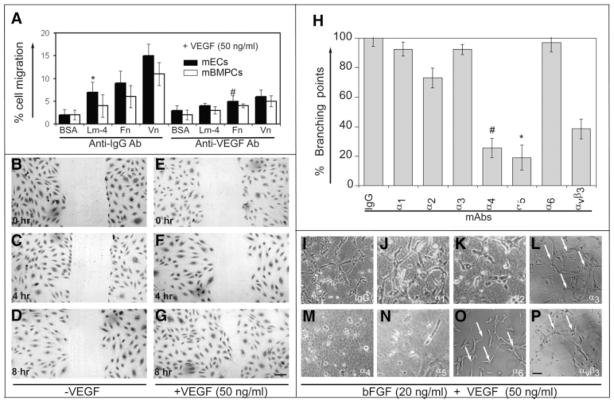Figure 1.
Migration of mBMPCs requires the action of VEGF165 and mBMPCs morphogenic differentiation requires α4 and α5 integrins. (A): Haptotactic and chemotactic movement of mBMPCs in response to the chemoattractant VEGF165 (50 ng/ml) were analyzed as described in Materials and Methods. Data from three independent experiments are expressed as mean ± SEM. *, p < .05; #, p < .02. Wound closure (B–D) in the absence or (E–G) in the presence of VEGF165 was examined as described in Materials and Methods. mBMPCs were fixed and stained with eosin. Magnification 200×. Bar 200 μm. (H–P): mBMPCs were pre-incubated with control IgG or with indicated mAbs (50 μg/ml) and cultured in the presence of bFGF and human recombinant VEGF165. After 8 hours, fresh media were added containing the indicated mAbs (50 μg/ml). mBMPCs formed elongated structures and mosaics of interconnections (branching) after 16 hours. Data are representative of at least three independent experiments. Data were calculated and expressed as % branching points. n = 15; *, p < .01 versus mBMPCs plated on BSA; #, p < .02 versus mBMPCs plated on BSA. Magnification 200×. Scale bar, 150 μm. Abbreviations: bFGF, basic fibroblast growth factor; BSA, bovine serum albumin; ECs, endothelial cells; Fn, fibronectin; lm, laminin; mBMPCs, mouse bone-marrow-derived progenitor cells; VEGF, vascular endothelial growth factor.

